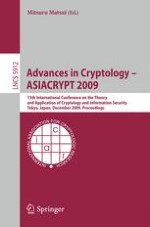This book constitutes the refereed proceedings of the 15th International Conference on the Theory and Application of Cryptology and Information Security, ASIACRYPT 2009, held in Tokyo, Japan, in December 2009. The 41 revised full papers presented were carefully reviewed and selected from 298 submissions. The papers are organized in topical sections on block ciphers, quantum and post-quantum, hash functions I, encryption schemes, multi party computation, cryptographic protocols, hash funtions II, models and frameworks I, cryptoanalysis: square and quadratic, models and framework II, hash functions III, lattice-based, and side channels.
